10 Essential Examples of Software Development You Should Know
Curious about different examples of software development? This article explores 10 major types, from web development and mobile apps to AI and embedded systems. Learn how each example impacts our digital landscape and see where each fits in the tech ecosystem.
Key Takeaways
-
Software development encompasses diverse fields, including web, mobile, desktop, and cloud computing, each with distinct methodologies and technologies.
-
Security software development focuses on safeguarding systems against evolving cyber threats, emphasizing the need for continuous improvements and ethical hacking practices.
-
AI and machine learning development are crucial for creating smart applications that analyze data to enhance efficiency, utilizing techniques like deep learning and predictive analytics.
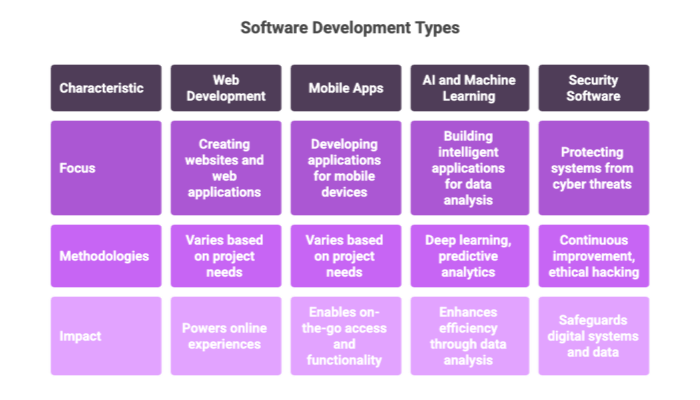

Web Development
Web development is the cornerstone of the internet, involving the creation of web applications by designing, developing, testing, and maintaining them. This field is divided into three main areas: front-end development, back-end development, and full-stack development.
Front-end development focuses on the user interface and user experience, leveraging technologies like HTML, CSS, and JavaScript to create engaging and interactive web applications. This is where the visual elements come to life, making the web application not only functional but also aesthetically pleasing. Skilled software engineers in this area ensure that users have a seamless and enjoyable experience.
Back-end development, on the other hand, involves coding and programming the server side of web applications. This is crucial for data processing and management. A full-stack developer takes on both front-end and backend development tasks, ensuring seamless integration across all layers of the web application. Understanding both front-end and back-end processes makes full-stack developers invaluable in software development projects.
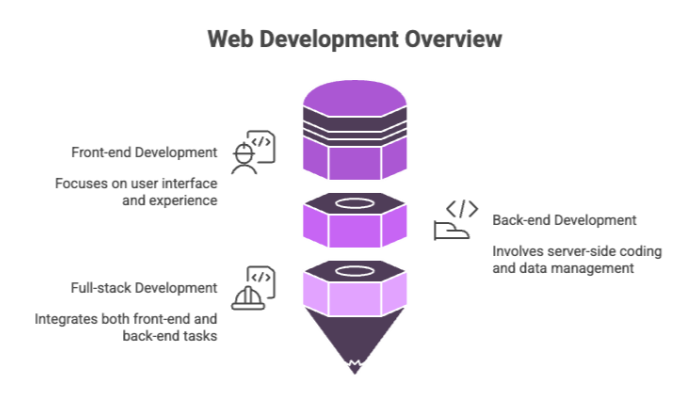

Mobile App Development
Mobile app development has revolutionized the way we interact with technology, enabling us to access information, services, and entertainment on the go. This types of software development focuses on creating mobile applications for mobile devices, including smartphones and tablets, and is a key aspect of mobile development, particularly for mobile developers.
Mobile app development includes several strategies. These are native, hybrid, and web app development. Native apps are built specifically for one platform, such as Android or iOS, using languages like Kotlin for Android and Swift for iOS. These apps offer optimal performance and take full advantage of the device’s capabilities.
Hybrid apps, on the other hand, are created using web technologies like HTML, CSS, and JavaScript and can run on multiple platforms. Frameworks like Flutter and React Native enable developers to write a single codebase that works across different operating systems, enhancing consistency and reducing development time. The programming language behind Flutter, Dart, enables fast development cycles, making it a popular choice among developers.
E-commerce and social media applications are common examples of mobile apps, showcasing the diverse applications of mobile app development. With the rapid evolution of new languages and frameworks, rapid application development continues to offer innovative solutions that meet the ever-changing needs of users.
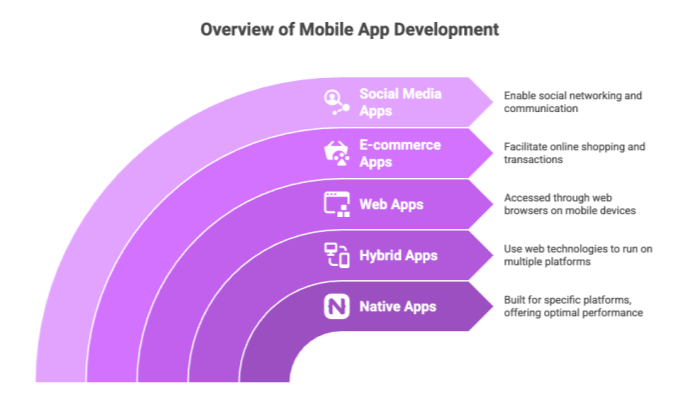

Desktop Software Development
Desktop software development refers to creating applications for desktop and laptop devices, running on operating systems like Windows, Mac, or Linux. These applications are designed to take full advantage of the powerful computing capabilities, larger displays, and richer user interfaces available on desktop computers. A software developer plays a crucial role in this software project at a custom software development company.
One of the key benefits of desktop applications is their ability to function offline, allowing users to access them without an internet connection. This is particularly beneficial in areas with low connectivity. Examples of comprehensive desktop software programs include Microsoft Office, which includes multiple applications catering to different needs. Specialized desktop applications like media players and editing software, such as VLC and Adobe Premiere Pro, highlight the versatility of desktop software solutions and the need to maintain software applications.
Cross-platform desktop applications use frameworks like Electron or Qt to run on multiple operating systems with minimal changes. This flexibility allows developers to reach a broader audience without having to rewrite significant portions of their codebase. A systematic software testing approach is crucial in desktop application development to ensure optimized functionality and performance.
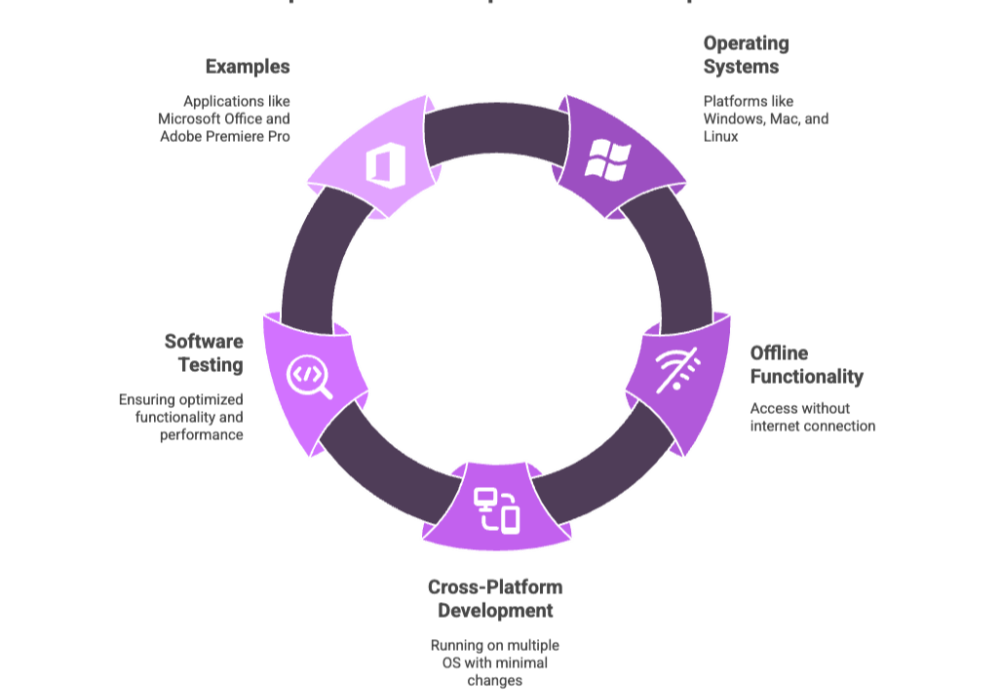

Cloud Computing Development
Cloud computing development has transformed the software development landscape by providing access to computing resources over the internet. This allows users to leverage remote servers for storage, processing, and management, leading to significant cost savings by eliminating the need for extensive hardware investment.
Building applications in the cloud offers numerous advantages, including automated scalability and high availability. Cloud-native applications are designed to be resilient, maintaining functionality even if one component fails. This ensures that applications can handle workload increases without manual intervention, simplifying the software development lifecycle by integrating development, testing, and deployment to create applications in one environment.
Major cloud services providers like AWS and Google Cloud Platform offer a suite of services, including computing power, storage, and analytics. These services enable developers to quickly provision resources, significantly shortening the time needed for software updates and deployments.
A well-known example of a cloud-based application is Google Docs, which allows users to create and edit documents online.


Embedded Systems Development
Embedded systems development involves building applications for unconventional hardware connected to networks. These software systems are integral to a wide range of devices, from digital cameras to medical devices, requiring specialized custom software development to function efficiently.
Common programming languages for embedded software include C, Python, and JavaScript. These languages are chosen for their ability to provide precise control over hardware components and efficient memory management. Real-time operating systems (RTOS) are frequently utilized in embedded applications to manage tasks predictably, ensuring that critical operations are performed within specified time constraints.
Middleware plays a crucial role in embedded systems, facilitating communication between the operating system and application software. Certain embedded systems, like those in medical devices, may run on specialized operating systems such as VxWorks or FreeRTOS, providing the necessary reliability and performance for critical applications.
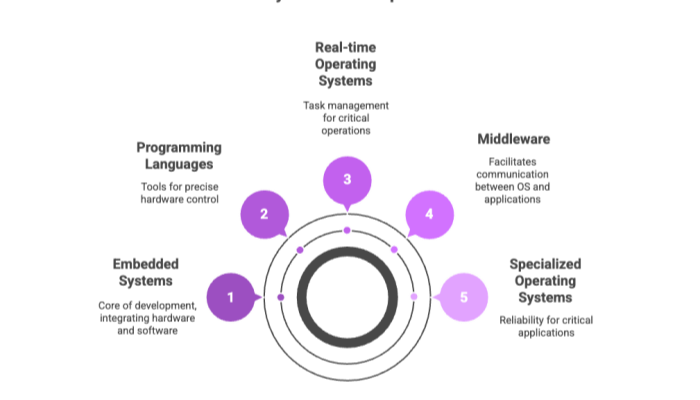

Game Development
Game development is the art and science of creating video gaming applications, ranging from simple mobile games to complex console and PC games. This process involves the creation of narratives, characters, environments, game mechanics, and controls, following steps such as concept generation, defining front-end features, programming back-end code, testing, and releasing.
Different programming languages and frameworks have their own strengths in video game development. For instance, writing code in Unity and Unreal Engine are popular frameworks that offer robust tools for creating immersive gaming experiences. Unity uses C#, while Unreal Engine uses C++ and Blueprints, providing flexibility and control over game mechanics and performance.
The game development process is dynamic generation and iterative, requiring continuous testing and optimization to ensure a smooth and engaging user experience. The collaboration between artists, designers, and developers is crucial in bringing the game’s vision to life, making it a truly interdisciplinary field. The software development process is similarly collaborative and iterative, encompassing the entire development process, which is essential for effective project management.
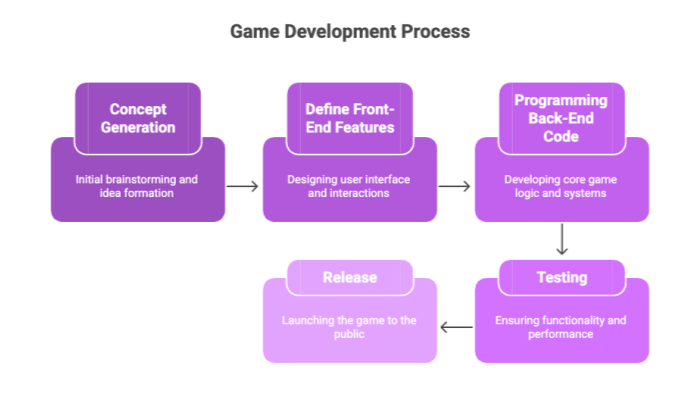

API Development
API development, or Application Programming Interface development, is central to building and maintaining the middle layer between the front end and back end of software applications. APIs allow software applications to communicate and interact with each other, ensuring smooth communication and seamless data exchange between systems.
Developers establish APIs to connect applications with other applications and systems, simplifying development and reducing complexity. Instead of developing new functionality from scratch, developers can use existing APIs, enabling them to integrate various services and features quickly. An example of this is a weather app accessing real-time data from a weather service via an API.
APIs play a vital role in modern software development, allowing for more efficient and flexible integration of different software components and technical specifications. This ensures that applications can leverage the best available services and functionalities, enhancing overall user experience.
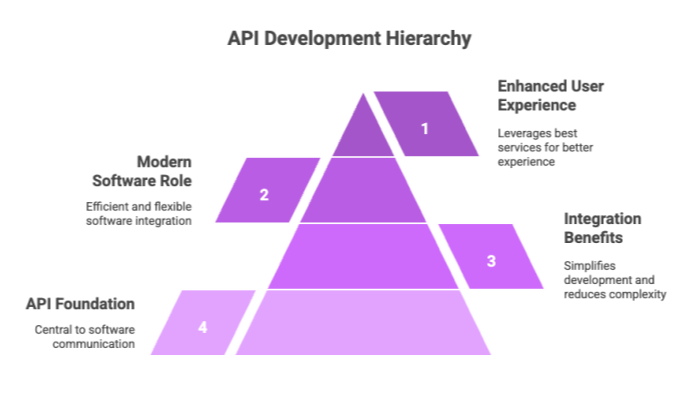

Data Science and Analytics
Data science and analytics are critical components of modern software development, enabling businesses to make data-driven decisions. Python and R are the leading programming languages in this field, each offering unique strengths for analysis and visualization.
Python is favored for its versatility across various software domains and is recognized for its readability, making it an excellent choice for beginners in data science. It has extensive library support, including popular tools like Pandas for data manipulation and Matplotlib for data visualization.
R, on the other hand, excels in statistical analysis and data visualization, with nearly 19,000 packages available on the Comprehensive R Archive Network (CRAN). Both languages can be integrated into workflows, allowing users to leverage Python’s data processing capabilities alongside R’s powerful visualization tools.
This integration provides a comprehensive approach to data science, enabling more accurate and insightful analysis.
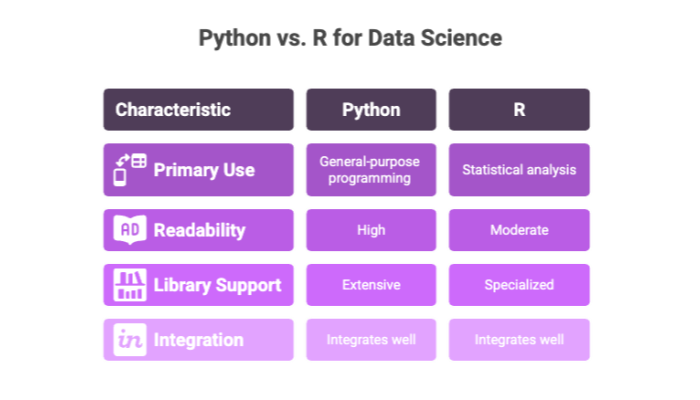

Security Software Development
Security software development focuses on protecting computer systems and networks from threats. The core objective of security engineers is to safeguard the internal technical infrastructure from external attacks, ensuring the integrity and confidentiality of data.
Cybersecurity is crucial because cyber threats continue to evolve, necessitating continuous improvement in security measures. Ethical hackers perform attempts to hack software to find vulnerabilities in the system, playing a key role in identifying and mitigating potential risks. Examples of security software include antivirus programs, which detect and remove malicious software, and encryption tools, which secure sensitive information by transforming it into unreadable code.
Firewalls act as barriers that control incoming and outgoing network traffic based on security rules, providing an additional layer of protection. Security software professionals also engage in penetration testing, data breach security management, and information system management, ensuring comprehensive protection of technological systems.
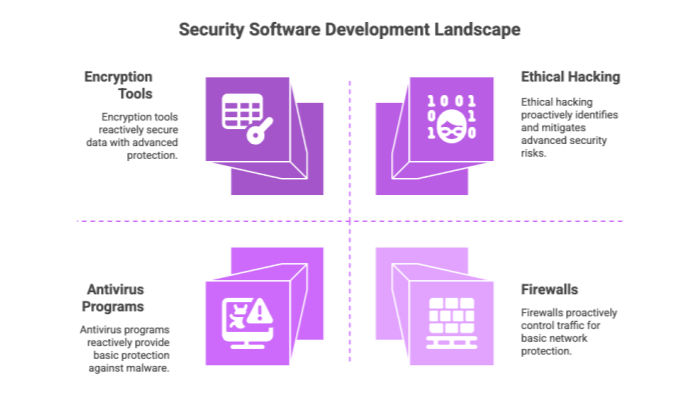

AI and Machine Learning Development
AI and artificial intelligence and machine learning development are at the forefront of technological innovation, enabling the creation of smart applications that can intelligently analyze vast amounts of data to improve efficiency. Machine learning includes several algorithms such as supervised, unsupervised, semi-supervised, and reinforcement learning, each serving different purposes in data analysis and prediction.
Deep learning, a subset of machine learning, allows for large-scale data analysis, making it possible to uncover patterns and insights that were previously unattainable. Predictive analytics, a key application of AI, enables businesses to make data-driven decisions, enhancing operational efficiency and strategic planning.
The development process for AI and machine learning applications involves extensive data collection, model training, and continuous optimization. Skilled software developers design these systems using a development model to automate processes and provide innovative solutions across various industries, from healthcare to finance.
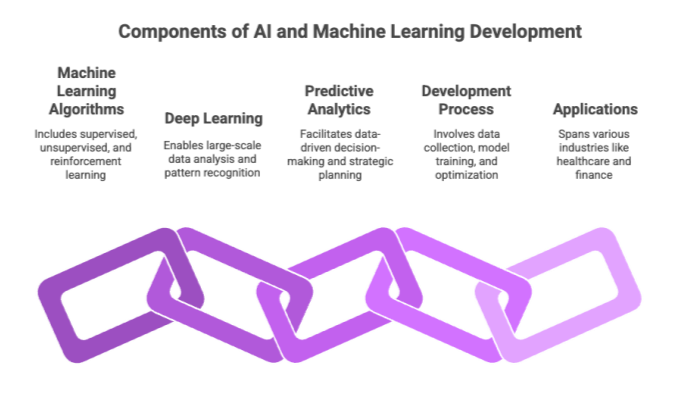

Summary
In this exploration of software development, we’ve journeyed through ten essential types, each contributing uniquely to the digital world. From the foundational web and mobile app development to the cutting-edge realms of AI and machine learning, each field offers exciting opportunities and challenges for software developers.
Understanding these types of software development not only broadens your perspective but also highlights the intricate processes and skilled professionals behind the software solutions we rely on daily. As technology continues to evolve, the role of software development becomes ever more critical, driving innovation and transforming the way we live and work.

Frequently Asked Questions
Frequently Asked Questions provide quick insights into common queries about different types of software development. This section aims to clarify key concepts and highlight important distinctions to help readers better understand the diverse aspects of software development.
What is the main difference between web development and mobile app development?
The main difference is that web development is about building applications accessible through web browsers, whereas mobile app development is aimed at creating applications designed specifically for mobile devices. This distinction dictates the tools and techniques used in each field.
Why is cloud computing development important in software development?
Cloud computing development is crucial in software development as it provides cost savings, scalability, and an integrated environment that streamlines the entire development lifecycle. By adopting cloud solutions, teams can enhance efficiency and responsiveness.
What are some common programming languages used in embedded systems development?
C is the most commonly used programming language in embedded systems development, alongside Python and JavaScript for specific use cases. These languages are favored for their efficiency and versatility in handling hardware-level programming.
How do APIs benefit software development?
APIs significantly enhance software development by enabling applications to communicate seamlessly, reducing complexity, and allowing developers to leverage existing functionalities, which ultimately accelerates the development process.
What roles do ethical hackers play in security software development?
Ethical hackers play a crucial role in security software development by identifying and mitigating vulnerabilities within the system, thereby enhancing overall security. Their proactive testing helps ensure that software is resilient against potential threats.

